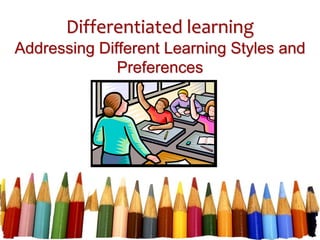
5405566 - Copy.pptx
- 1. Differentiated learning Addressing Different Learning Styles and Preferences
- 2. Agenda: 1. What is differentiated learning? 2. Different learning Styles and Preferences 3. How do we Differentiate Learning?
- 3. When Differentiating Instruction, The Three Most Important Questions to Continually Ask Yourself... What do I want my students to know, understand, and be able to do? What will I do instructionally to get my students to learn this? How will my students show what they know?
- 4. Why differentiate? • No two children are alike • No two children learn in the identical way • To provide access to the curriculum for all students • One size does not fit all
- 5. Why is differentiating instruction a form of Intervention? • Intervention must take a broader view than that of simply supplying repetitious skill practice. • To succeed in math, students need a solid conceptual base, ways to model their thinking, and a repertoire of strategies. • Differentiation is preventative. • Meeting the needs of struggling students is effective teaching.
- 6. What is differentiation? • Meeting students where they are: Abilities Interests Learning styles • The recognition of students’ varying background knowledge • Instruction that appeals to students’ differences
- 7. Ways Teachers Can Differentiate Content Process Product Knowledge and skills Varying learning activities or strategies Varying complexity/choice (tiered assignments)
- 8. First Steps: Preparing for Differentiation • Identify standard(s): learning goals and outcomes • Diagnose the difference in readiness, interests and learning styles of each student through various tools: Entrance tasks Exit Slips Observation Assessments
- 9. Use data to inform instruction • Reteaching to whole group? • Guided group; pairs practice? • Workstations and guided group? • One-on-one instruction?
- 10. Using MAP Data Class by RIT – Class by Goal
- 11. Differentiation Strategies •Curriculum compacting •Independent study •Interest centers •Flexible grouping •Learning contracts •Choice boards •Reading Counts •Tiered lessons Elementary Secondary •Graphic organizers •Think-Tac-Toe Elementary Secondary •Teacher centers •Mini lessons •Technology enhanced lessons •Cubes Elementary Secondary
- 12. Management Suggestions • Explain the activity and the procedures with the whole class • Make expectations clear – develop ground rules for: • Behavior • Performance • Use rich tasks that require time and thinking – this is not an extension of the “seat-work” concept • Provide clear instructions, materials, responsibilities, check points, and expectations (rubrics)
- 13. Create the Environment • Physical setting- – Use of space: create spaces to work – Teach in different areas of the room – Provide students access to materials they will need for projects – markers, chart paper, etc
- 14. Establish Routines • Teach students: – how to enter and exit the classroom – where and when to turn in work – how and when to ask for help – where to go for supplies – what to do when finished – how to transition in and out of groups
- 15. Emotional Tone • Affirmation Posters – For example – “Fair is not everyone getting the same thing, fair is everyone getting what they need to be successful” – “This is a risk-taking, mistake-making classroom” • Model Honor and Inspiration • Celebrate learning from mistakes
- 16. Hand-out: “A Math-Rich Physical Classroom Environment”
- 18. A Closer Look at Tiered Lessons
- 19. Tiered Lessons • Adapting directions – Simple Detailed – Specific Open-Ended – One step-at-a-time Multi-step • Adapting the complexity of the assignment
- 20. Tiered Lessons • Adapting directions – Simple Detailed – Specific Open-Ended – One step-at-a-time Multi-step • Adapting the complexity of the assignment – Hands-On Theoretical – Teacher-Led Student-Led
- 21. Sample Lesson: “A Great Feat” • Determine the focus standard(s). – Grade level, domain, cluster, standard • How can this lesson be improved for teaching the standard(s) at your grade level? Differentiation Strategies for Mathematics, Shell Education
- 22. Creating a Lesson • Hand-outs needed: – Common Core Standards (K-5) – “Instructional Priorities- Mathematics” – Tables 1 and 2 – Observations of Mathematical Instructional Practices
- 23. Creating a Lesson 1. Choose a standard at your grade level. 2. Identify your learning target(s). 3. Identify the resources needed. 4. Choose/Develop Instructional Strategies 5. How will you differentiate and assess? 6. Be ready to share with the group.
- 24. NWEA/MAP Resources • Hand-outs: – DesCartes Statements by RIT bands (skills) – Math DesCarte: Number Sense Lesson – Lesson Plan Template (using MAP data) www.foridahoteachers.org www.fortheteachers.org
- 25. www.nctm.or g
- 28. Teachers who differentiate find… • Greater understanding of the concepts behind the ‘rules’. • All students experience challenge. • Ability to apply concepts/skills to new situations and daily life. • Students are excited. • Students have ownership. • Students are more independent learners. • Students have greater mastery of content. • Students develop/hone problem solving skills. • Students are able to initiate their own tasks/projects.
- 29. Exit Slip 1. List one idea/strategy that you plan to implement with your students next week. 2. List one idea/strategy that you would like to research more in order to implement with your students this semester. 3. What questions do you have about differentiated instruction?
- 30. How can we continue to support your work? Diane Culbertson, NKCES www.DianeCulbertson.net Diane.Culbertson@nkces.org Jenny Ray, KDE/NKCES www.JennyRay.net Jenny.Ray@kde.gov
- 31. Resources/References Resources/References • www.foridahoteachers.org • www.fortheteachers.org • http://www.giftedsources.com/index.htm • http://www.tip.duke.edu/ • http://www.doe.in.gov/exceptional/gt/tiered_curriculum/welcome.html • http://www.diffcentral.com/index.html • http://daretodifferentiate.wikispaces.com/ • http://www.caroltomlinson.com/ • www.commoncore.org • Books: – Models of Intervention in Mathematics: Reweaving the Tapestry (NCTM) – Standards Based Activities & Assessments for the Differentiated Classroom 90 Instructional Strategies for the Classroom
